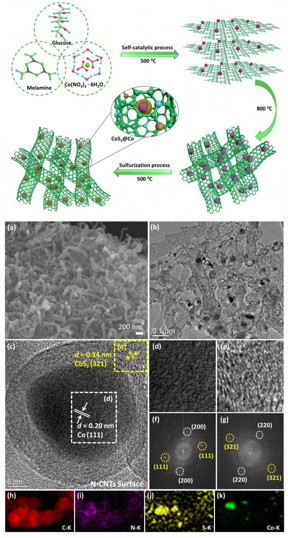Home > Press > S, N co-doped carbon nanotube-encapsulated CoS2@Co: Efficient and stable catalysts for water splitting
 |
| Schematic illustration and physical characterization of S, N co-doped carbon nanotubes encapsulated core-shell (CoS2@Co) nanoparticles. CREDIT ©Science China Press |
Abstract:
Electrochemical water splitting is favorable strategy to produce high-purity H2. The current mainstream catalysts for water electrolysis are precious metals (Pt, RuO2, IrO2), which possess superior catalytic activity, relatively low over-potential and favorable catalytic kinetics, but their high cost and poor cycle stability is still unaffordable. Therefore, it is urgent to develop a new type of hydrogen production catalyst with low cost, high catalytic activity and high stability.
S, N co-doped carbon nanotube-encapsulated CoS2@Co: Efficient and stable catalysts for water splitting
Beijing, China | Posted on September 10th, 2018Due to its low cost, high abundance, and good electrical conductivity, the transition metal-Co and its derivatives have shown great promise in electrocatalysis. However, stability has been a big issue due to their high chemical activities. To address this issue, encapsulation of Co nanoparticles into carbon shell has been proposed as an effective strategy to inherit the high electrocatalytic activity of the transition metal, and further prevent its corrosion from the harsh electrolytic environment. By tuning the metal composition and structure of carbon layers, the catalytic properties of these composites can be regulated.
Recently, Liu Zhao-Qing's group of Guangzhou University reports a bifunctional catalyst, transition metal cobalt ions induced the self-growth of nitrogen doped carbon nanotubes, which are further vulcanized to incorporate sulfur into the carbon nanotubes framework. The obtained materials (S, exhibit excellent HER and OER performance. As cathode and anode, S, can rapidly dissociate water molecules to produce hydrogen and oxygen gases, requiring only 1.633 V to reach a current density of 10 mA cm-2, and a strong stability under various operating currents is also observed.
####
For more information, please click here
Contacts:
Zhao-Qing Liu
Copyright © Science China Press
If you have a comment, please Contact us.Issuers of news releases, not 7th Wave, Inc. or Nanotechnology Now, are solely responsible for the accuracy of the content.
| Related Links |
| Related News Press |
News and information
![]() Simulating magnetization in a Heisenberg quantum spin chain April 5th, 2024
Simulating magnetization in a Heisenberg quantum spin chain April 5th, 2024
![]() NRL charters Navy’s quantum inertial navigation path to reduce drift April 5th, 2024
NRL charters Navy’s quantum inertial navigation path to reduce drift April 5th, 2024
![]() Discovery points path to flash-like memory for storing qubits: Rice find could hasten development of nonvolatile quantum memory April 5th, 2024
Discovery points path to flash-like memory for storing qubits: Rice find could hasten development of nonvolatile quantum memory April 5th, 2024
Nanotubes/Buckyballs/Fullerenes/Nanorods/Nanostrings
![]() Tests find no free-standing nanotubes released from tire tread wear September 8th, 2023
Tests find no free-standing nanotubes released from tire tread wear September 8th, 2023
![]() Detection of bacteria and viruses with fluorescent nanotubes July 21st, 2023
Detection of bacteria and viruses with fluorescent nanotubes July 21st, 2023
Discoveries
![]() Chemical reactions can scramble quantum information as well as black holes April 5th, 2024
Chemical reactions can scramble quantum information as well as black holes April 5th, 2024
![]() New micromaterial releases nanoparticles that selectively destroy cancer cells April 5th, 2024
New micromaterial releases nanoparticles that selectively destroy cancer cells April 5th, 2024
![]() Utilizing palladium for addressing contact issues of buried oxide thin film transistors April 5th, 2024
Utilizing palladium for addressing contact issues of buried oxide thin film transistors April 5th, 2024
Announcements
![]() NRL charters Navy’s quantum inertial navigation path to reduce drift April 5th, 2024
NRL charters Navy’s quantum inertial navigation path to reduce drift April 5th, 2024
![]() Discovery points path to flash-like memory for storing qubits: Rice find could hasten development of nonvolatile quantum memory April 5th, 2024
Discovery points path to flash-like memory for storing qubits: Rice find could hasten development of nonvolatile quantum memory April 5th, 2024
Energy
![]() Development of zinc oxide nanopagoda array photoelectrode: photoelectrochemical water-splitting hydrogen production January 12th, 2024
Development of zinc oxide nanopagoda array photoelectrode: photoelectrochemical water-splitting hydrogen production January 12th, 2024
![]() Shedding light on unique conduction mechanisms in a new type of perovskite oxide November 17th, 2023
Shedding light on unique conduction mechanisms in a new type of perovskite oxide November 17th, 2023
![]() Inverted perovskite solar cell breaks 25% efficiency record: Researchers improve cell efficiency using a combination of molecules to address different November 17th, 2023
Inverted perovskite solar cell breaks 25% efficiency record: Researchers improve cell efficiency using a combination of molecules to address different November 17th, 2023
![]() The efficient perovskite cells with a structured anti-reflective layer – another step towards commercialization on a wider scale October 6th, 2023
The efficient perovskite cells with a structured anti-reflective layer – another step towards commercialization on a wider scale October 6th, 2023
Water
![]() Taking salt out of the water equation October 7th, 2022
Taking salt out of the water equation October 7th, 2022
|
|
||
|
|
||
| The latest news from around the world, FREE | ||
|
|
||
|
|
||
| Premium Products | ||
|
|
||
|
Only the news you want to read!
Learn More |
||
|
|
||
|
Full-service, expert consulting
Learn More |
||
|
|
||








